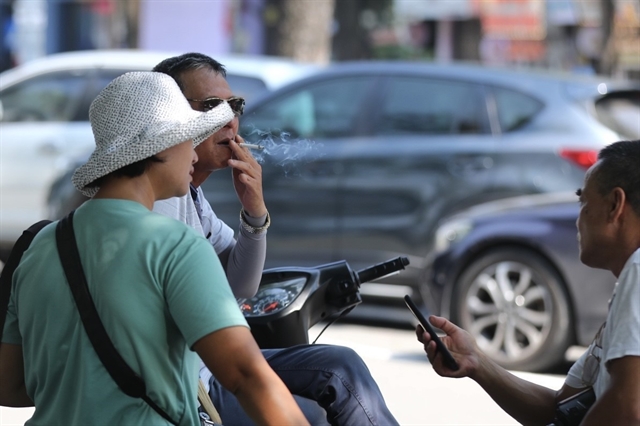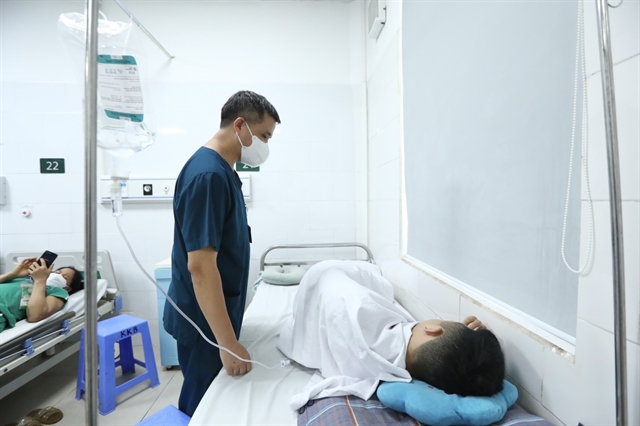 Society
Society

 |
| A man spokes in public in Hà Nội. — VNA/VNS Photo Minh Quyết |
HÀ NỘI — The use of tobacco, including e-cigarettes, heated tobacco, and shisha products, has been increasing in recent times in Việt Nam, which requires authorities to have comprehensive solutions in place to minimise the harm, the Ministry of Health has said.
Ten years after implementing the Law on Prevention and Control of Tobacco Harms, the country has achieved significant results. However, Việt Nam is still one of the 15 countries with the highest number of adult male smokers in the world.
Figures from the ministry in 2020 showed that although the number of adult male smokers decreased to 42.3 per cent, the number was still high and failed to reach the target of 39 per cent set in the Tobacco Harm Prevention Strategy by 2020.
 |
| Police in Đà Nẵng City seize e-cigarettes and various types of e-cigarette liquids without proper origin. — VNA/VNS Photo |
In response to World No Tobacco Day (May 31) and National No Tobacco Week (May 25-31), Deputy Minister Trần Văn Thuấn said in recent years, new-generation tobacco products such as e-cigarettes, heated tobacco products, and shisha have appeared. These products are currently not allowed to be imported, sold, or circulated in the domestic market, he said.
However, they have been advertised and traded illegally, especially on the Internet and among youngsters. These products are designed in various styles and flavours, leading to a rapid increase in the use of e-cigarettes and heated tobacco products among school-age students, he said.
The problem is that smokers tend to add e-cigarettes to their smoking habits and non-smokers tend to try these products and become smokers.
As a result, the rate of using e-cigarettes and heated tobacco products has been increasing faster than that of smoking cigarettes. Tobacco companies usually focus on advertising e-cigarette products to attract young people and create a new generation of tobacco addicts.
Dr Lê Hoàn from Hà Nội Medical University Hospital said e-cigarettes are very harmful to the health of both active and passive smokers due to chemicals used in e-cigarette production, such as nicotine, an addictive substance found in regular cigarettes, smoke-generating solution and flavouring agents.
Strong measures
According to health experts, limiting the use of cigarettes and e-cigarettes is not a simple task, even for developed countries. The role of schools and families is crucial in helping youngsters refrain from smoking. Young people must be equipped with knowledge about the harms of tobacco.
They suggested increasing the special consumption tax on these products and issuing policies to ban the circulation of e-cigarettes and heated tobacco products in Việt Nam as recommended by the ministry and the World Health Organization (WHO).
They also stressed education to raise awareness of the harmful effects of tobacco, as well as promote the responsibility of parents and teachers, are crucial.
 |
| Smoking in public areas not only affects the smoker negatively, but also causes harmful impacts to non-smokers. — VNA/VNS Photo Minh Quyết |
According to the World Bank and WHO assessment, price and taxes are the most important policies for tobacco control to help reduce smokers. Other measures come from enforcing smoke-free environments, implementing health warning labels on tobacco products, promoting tobacco harm awareness, banning tobacco advertising, and providing support for tobacco cessation.
Special taxes have proven effective with the youth group, they said. A 10 per cent increase in tobacco prices can reduce smokers by approximately 10 per cent or more among young people.
The WHO and World Bank have recommended that the share of tobacco taxes in retail prices should reach 75 per cent to have a significant impact on reducing consumption. Increasing taxes on tobacco can also reduce the number of people living in poverty in Việt Nam, contributing to preventing premature deaths from smoking and alleviating the burden of healthcare costs associated with tobacco.
The Ministry of Health has suggested the adjustment of the Law on Prevention and Control of Tobacco Harms with the addition of regulations on e-cigarette and heated tobacco products to control and minimise the use of e-cigarettes and new-generation cigarettes.
 |
| A patient, suspected of drug poisoning contained in e-cigarette essential oil, is being treated at the Bạch Mai Hospital's Poison Control Centre in Hà Nội. — VNA/VNS Photo |
Recently, Deputy Prime Minister Trần Hồng Hà signed a decision issuing a national strategy on tobacco harm prevention and control until 2030.
Under the strategy, Việt Nam is striving to reduce the rate of tobacco use among males aged 15 and above to less than 36 per cent in the 2023-25 period.
According to a research of the ministry's Vietnam Tobacco Control Fund, the rate of passive smoking in public places is relatively high. On average, nearly 80 per cent of people are exposed to secondhand smoke in restaurants, and 65 per cent in hotels.
The strategy aims to reduce the rate of people exposed to passive smoking to less than 75 per cent at restaurants, below 80 per cent at bars and cafes, and below 60 per cent at hotels by 2030.
Thuận said that the implementation of the strategy aims to ensure the right of all people, especially non-smokers, to live, work and study in a smoke-free environment. — VNS
World No-Tobacco Day: ensuring rights to a smoke-free environmentAccording to the World Health Organization, the nicotine contained in tobacco is highly addictive, and tobacco use is a major risk factor for cardiovascular and respiratory diseases, over 20 different types or subtypes of cancer, and many other debilitating health conditions.Every year, more than eight million people die from tobacco use. Most tobacco-related deaths occur in low- and middle-income countries, which are often targets of intensive tobacco industry interference and marketing.Smoking rates tend to increase in developing countries. Every day, approximately 21,000 people die and on average one person dies from smoking every four seconds.Tobacco can also be deadly for non-smokers. Second-hand smoke exposure has also been implicated in adverse health outcomes, causing 1.2 million deaths annually.Nearly half of all children breathe air polluted by tobacco smoke and 65,000 children die each year due to illnesses related to second-hand smoke. Smoking while pregnant can lead to several life-long health conditions for babies.The WHO estimates that the global economic loss caused by tobacco each year is US$1.4 trillion. Globally, about 3.5 million hectares of land are converted to tobacco crops per year. Nine of the ten largest tobacco-growing countries in the world are low- and middle-income countries, of which four are identified as being food deficient.Every year, about 5 per cent of the forest area is cleared to grow tobacco, as well as to get wood for tobacco drying. It is estimated that 18 billion trees are needed each year to make firewood for tobacco drying. Annually, the use of tobacco releases into the environment between 3,000 and 6,000 tonnes of formaldehyde (H2CO), along with 12,000 to 47,000 tonnes of nicotine, and from 300-600 million kilograms of toxic waste.Responding to World No-Tobacco Day (May 31), a National No-Tobacco Week has been held from May 25-31 with various activities in many localities to raise awareness of tobacco harms and reduce the percentage of smokers in the community. The activities include a marathon-themed “Vietnamese youngster say no to e-cigarettes”. VNS




